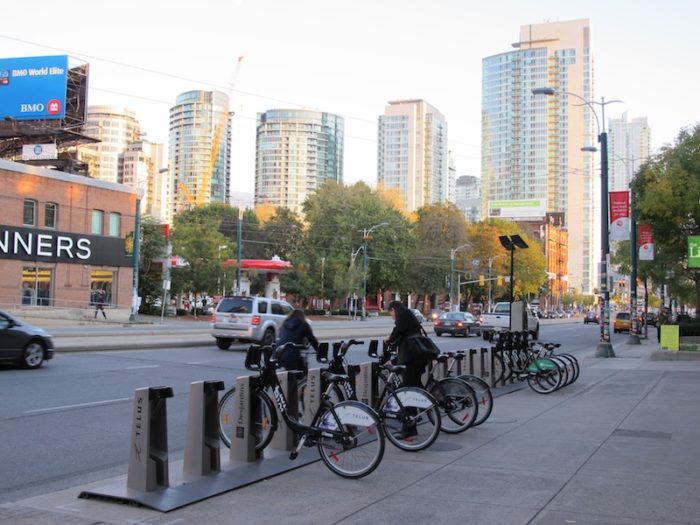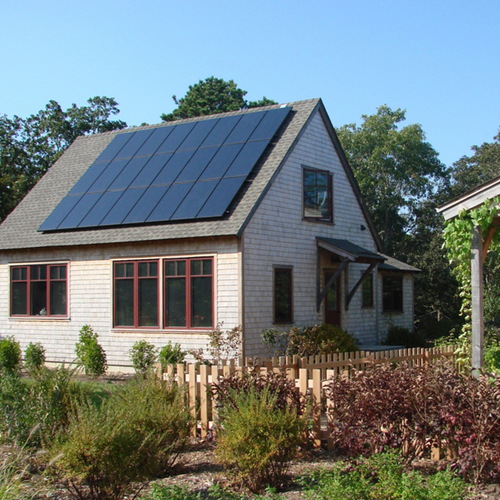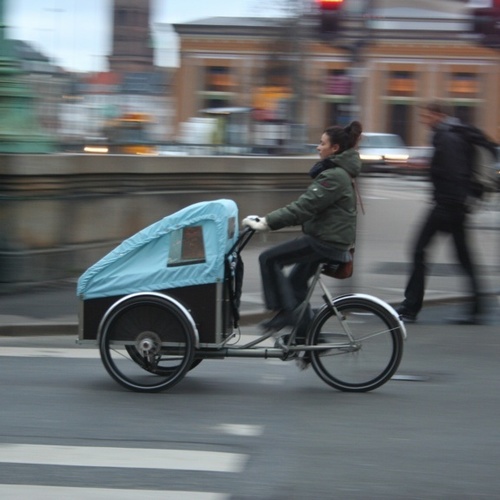
Image Credit: Alex Wilson
Last week I laid out some arguments on why we should wean ourselves from fossil fuels, and offered some suggestions of how we could go about doing that in our homes — by superinsulating, switching to oil- and gas-free heating, and converting to renewable electricity. Those steps certainly aren’t easy or inexpensive, but there’s a pretty clear path for doing so.
With transportation it’s a lot more challenging, particularly in non-urban areas where we’re more dependent on automobiles. Petroleum is uniquely suited to fueling our cars and trucks. Gasoline and diesel are highly concentrated fuels that allow a little to go a long way. They are liquid at the conditions where we use them without putting them under pressure, so we can pump them into our fuel tanks relatively easily and with (relatively) low risk.
What are the options if we want to get off fossil fuels?
1. Avoid the car and walk or bike
The easiest and most obvious strategy for eliminating fossil fuels for transportation is to walk or ride a bike. New York City is the most pedestrian-friendly city in America. Most of my friends who live in NYC don’t even own cars. Indeed, unless you’re willing to spend the megabucks needed for a private garage, going without a car is far more convenient than having one — just ask anyone who has to move his or her car two or three times a week to provide for street cleaning. The density is high enough that walking and public transit (more on that below) allow residents to give up their private vehicles.
Biking extends the range for getting around without a motorized vehicle. If we can walk up to a mile (in about 20 minutes) with reasonable convenience, then we could bike six or seven miles.
I live in West Dummerston, and in good weather I enjoy the seven-mile ride to my office in Brattleboro, mostly along Route 30 (with one of the better shoulders in the region); sometimes I even bike in on the newly created West River Trail — though it’s a little rough for my touring bike. By walking or biking, you not only save money by avoiding the nearly $4/gallon gasoline, but you get free exercise and a chance to get lost in your own thoughts.
In a few European cities, such as Amsterdam and Copenhagen, bicycling now accounts for 30-40% of all trips. In Portland, Oregon, among the most bicycle-friendly cities in America, 6-8% of all commuting is now by bike, according to the Portland Bureau of Transportation — not much by European standards, but the highest of any large U.S. city.
2. Redesign our communities so that cars aren’t needed
Walking, biking, or taking public transit isn’t just a personal decision; it also depends on infrastructure that supports it. A key to the long-term goal of getting off fossil fuels to redesign our communities with an emphasis on pedestrians, bikes, and public transit, rather than on the automobile.
Strategies to create more pedestrian-friendly communities include mixed-use development (where we can work and shop closer to where we live), greater density that will support public transit, the creation of bike lanes and biking/walking pathways, and traffic calming practices to create safer streets that invite walking and biking. Bringing about these changes takes time and necessitates becoming active on planning commissions, select boards, development review boards, and other municipal bodies.
3. Switch to bio-based fuel
Some years ago, when we had a VW Passat TDI diesel wagon, we ran it on biodiesel (a fuel that performs much like petroleum diesel but is refined from vegetable oil). I used 100% biodiesel (B100) for a while, but when a local service station in Brattleboro started carrying B20 (20% biodiesel) I decided to switch to that and avoid having to lug 55-gallon drums of the fuel down into my basement and then use a hand pump to pump it into 5-gallon cans that I would lug up to my car. I was no longer fossil-fuel-free with the Passat, but I was supporting a local company that had made a commitment to enter the biodiesel business.
Friends of mine have converted diesel vehicles to run on unrefined vegetable oil — usually used cooking oil that they get from restaurants. These are often called grease-car conversions, and it’s necessary to pre-heat the fuel using standard diesel before switching over to grease, so a second fuel tank has to be installed. It’s a bit more work — more than I was willing to do — though I admire people who are that committed.
4. Go with an all-electric or plug-in hybrid vehicle and use electricity from renewable sources
Another option for getting off petroleum is to buy an electric vehicle or one of the plug-in hybrid vehicles that have recently entered the market, such as the Chevy Volt or Prius Plug-In. I’ve been hoping that our 2003 Honda Civic Hybrid, with about 160,000 miles on it, will hang on long enough that I can replace it with an affordable plug-in hybrid and then use excess capacity from the solar electric (photovoltaic) system that we plan to install on our barn.
I did some back-of-the-envelope calculations a while ago and found that if I oversized my PV system by just 1 kW of capacity (over what I need for a net-zero-energy house) I would produce about 1,200 kWh of excess electricity, an average of 3.3 kWh per day. That would be enough to drive about 12 miles per day solely on our own site-generated electricity. This calculation assumes 275 watt-hours per mile, which is the high end of the range a friend of mine achieves with a Prius that he converted to a plug-in configuration.
5. Use public transit and lobby for greener energy sources
Particularly in less rural areas, biodiesel buses, hybrid-electric buses, and electric trolleys and light-rail systems provide another option for getting off fossil fuels with out transportation. All-electric transit options pollute far less than their diesel counterparts, but they can be even greener if the municipality invests in its own renewable energy system or commits to renewable energy credits for its power. This renewable electricity can be from wind farms, Cow Power (in Vermont), landfill methane, solar, or other renewable options.
There is often an extra cost for a municipality to switch to green electricity, but I believe it’s a good investment for many reasons—including public health and supporting the local economy. With various investment options available, this can be a financially attractive option, even for a small town like Brattleboro. It can also be an attractive option for a private company operating a public transit system.
Alex is founder of BuildingGreen, Inc. and executive editor of Environmental Building News. He also coauthored BuildingGreen’s special report on windows that just came out. To keep up with Alex’s latest articles and musings, you can sign up for his Twitter feed.
Weekly Newsletter
Get building science and energy efficiency advice, plus special offers, in your inbox.














One Comment
total impact is key
Alex -
Appreciate your continued highlighting of the impacts of buildings beyond their own energy consumption, in terms of what patterns their location locks us into. The more dense/compact we build, the more energy we save in both columns: shorter commutes that facilitate lower-energy mode choices; and more efficient buildings (more adiabatic surfaces). And more open land nearby for growing food...so transport savings there too. So I would push back a little on those that argued here (in 2009?) that a 'source' energy basis puts the focus back on building energy, from transport...It's easier to retrofit with new technologies than to change development and ownership patterns.
I've also thought that we would do well to put more emphasis on energy use per occupant, rather than per square foot. Doubling the occupancy of a house can cut its per-capita energy use significantly (not half, though, of course); doubling the population density of sites (even with a separate unit, which isn't ideal) can push the area toward being able to support public transit, or a more nearby grocery, or other services...
For similar reasons, perhaps, I get a little tired of the 'tiny-' or 'micro-' house movement, with its fixation on simply repeating the pattern, but smaller...a kind of glorified camping, or clubhouse. Cabins on wheels start to feel like a step backwards, a fad that doesn't address the larger issues of what it takes to learn how to live near each other, in compact and reasonably dense communities, and share things, like roofs and foundations and stairs... ;) Far more interesting architecturally, and constructionally, to find ways to remodel existing single-family homes to make them multi-family...!
Log in or create an account to post a comment.
Sign up Log in